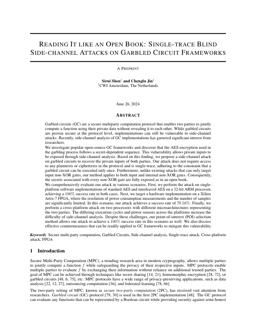2024-06-26
Reading it like an open book: Single-trace blind side-channel attacks on garbled circuit frameworks
Publication
Publication
Garbled circuits (GC) are a secure multiparty computation protocol that enables two parties to jointly compute a function using their private data without revealing it to each other. While garbled circuits are proven secure at the protocol level, implementations can still be vulnerable to side-channel attacks. Recently, side-channel analysis of GC implementations has garnered significant interest from researchers.We investigate popular open-source GC frameworks and discover that the AES encryption used in the garbling process follows a secret-dependent sequence. This vulnerability allows private inputs to be exposed through side-channel analysis. Based on this finding, we propose a side-channel attack on garbled circuits to recover the private inputs of both parties. Our attack does not require access to any plaintexts or ciphertexts in the protocol and is single-trace, adhering to the constraint that a garbled circuit can be executed only once. Furthermore, unlike existing attacks that can only target input non-XOR gates, our method applies to both input and internal non-XOR gates. Consequently, the secrets associated with every non-XOR gate are fully exposed as in an open book. Fundamentally, this work challenges the standard non-collusion assumption in multi-party computation, arguing for the necessity of extending it to the physical layer.We comprehensively evaluate our attack in various scenarios. First, we perform the attack on single-platform software implementations of standard AES and interleaved AES on a 32-bit ARM processor, achieving a 100% success rate in both cases. Next, we target a hardware implementation on a Xilinx Artix-7 FPGA, where the resolution of power consumption measurements and the number of samples are significantly limited. In this scenario, our attack achieves a success rate of 79.58%. Finally, we perform a cross-platform attack on two processors with different microarchitectures representing the two parties. The differing execution cycles and power sensors across the platforms increase the difficulty of side-channel analysis. Despite these challenges, our point-of-interest (POI) selection method allows our attack to achieve a 100% success rate in this scenario as well. We also discuss effective countermeasures that can be readily applied to GC frameworks to mitigate this vulnerability.
| Additional Metadata | |
|---|---|
| , , , , , | |
| Organisation | Computer Security |
|
Shen, S., & Jin, C. (2024). Reading it like an open book: Single-trace blind side-channel attacks on garbled circuit frameworks. |
|


